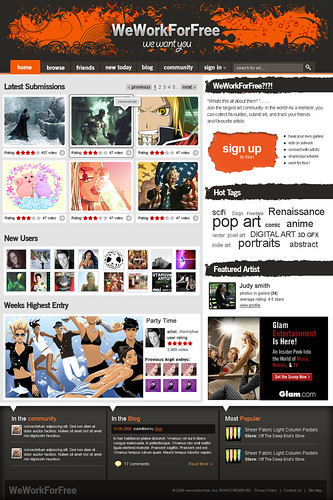Many people want to learn to become a good web designer, yet they aren't sure if they have what it takes to become good in the subject. Anyone can be a good web designer they just have to learn how to first, the more you learn from places like this article the better you are sure to become at web design.
If you're working on web design use the right graphics for the job. Remember, bitmap images are huge and usually don't work well, PNGs work fine. For screenshots, text buttons, and other non-photographic images, use PNG if the image has more than 256 colors, and GIF if not. For photos, you can use JPEG images.
Let people cancel any action they have started. Actions may involve searching the website for archives or a variety of topics, signing up for newsletters and notifications, or simply filling out forms. If visitors cannot cancel an action they are not interested in, such as providing their contact information, they will feel they do not have a choice and won't buy anything.
Avoid excessive use of pop-up windows. Pop-ups are an irritating distraction, at best, for most web surfers, and the possible benefits you could reap with them are extremely modest. As a result, your users may just go away from your site, too angry to come back.
Avoid using animated GIFs on your site. These were popular in the late 1990s, but newer technologies have replaced the uses for animated GIFs that were actually useful. Animated GIFs are low in quality and large in file size. Use static icons for page elements and actual video files for complex animations.
Try having a clear and consistent layout in the design of your sites. Clean layouts that make use of a lot of white space tend to enhance the site's readability and overall look. The layout must be focused on the content. Try using fonts that are on every computer in order to avoid having your site appear incorrectly.
Optimize load times on your website. If visitors must wait a long time for something to load, they will want to leave the site. Try reducing your number of graphics, Flash, and script on your pages, optimizing your HTML, using SSI files, using client and server caching, creating expire headings, and minimizing your JS and CSS coding.
Pages of a website are very important for even the smallest sites, so make sure that you really have an eye for detail. You need to make sure that the latest page you have added to your site has the same dimensions and features of your previous pages. The last thing you want is a hodgepodge of different styles and themes on one site.
Using the advice from this article you can become a good web designer in no time, and you should now feel a bit more confident and think so as well. So now that you have some insightful knowledge on the subject you can apply that towards your web design efforts and become a great designer of websites in no time.
If you're working on web design use the right graphics for the job. Remember, bitmap images are huge and usually don't work well, PNGs work fine. For screenshots, text buttons, and other non-photographic images, use PNG if the image has more than 256 colors, and GIF if not. For photos, you can use JPEG images.
Let people cancel any action they have started. Actions may involve searching the website for archives or a variety of topics, signing up for newsletters and notifications, or simply filling out forms. If visitors cannot cancel an action they are not interested in, such as providing their contact information, they will feel they do not have a choice and won't buy anything.
Avoid excessive use of pop-up windows. Pop-ups are an irritating distraction, at best, for most web surfers, and the possible benefits you could reap with them are extremely modest. As a result, your users may just go away from your site, too angry to come back.
Avoid using animated GIFs on your site. These were popular in the late 1990s, but newer technologies have replaced the uses for animated GIFs that were actually useful. Animated GIFs are low in quality and large in file size. Use static icons for page elements and actual video files for complex animations.
Try having a clear and consistent layout in the design of your sites. Clean layouts that make use of a lot of white space tend to enhance the site's readability and overall look. The layout must be focused on the content. Try using fonts that are on every computer in order to avoid having your site appear incorrectly.
Optimize load times on your website. If visitors must wait a long time for something to load, they will want to leave the site. Try reducing your number of graphics, Flash, and script on your pages, optimizing your HTML, using SSI files, using client and server caching, creating expire headings, and minimizing your JS and CSS coding.
Pages of a website are very important for even the smallest sites, so make sure that you really have an eye for detail. You need to make sure that the latest page you have added to your site has the same dimensions and features of your previous pages. The last thing you want is a hodgepodge of different styles and themes on one site.
Using the advice from this article you can become a good web designer in no time, and you should now feel a bit more confident and think so as well. So now that you have some insightful knowledge on the subject you can apply that towards your web design efforts and become a great designer of websites in no time.
